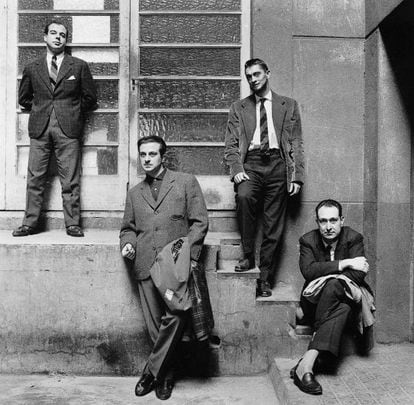
Writers Jaime Gil de Biedma, José Agustin, Goytisolo, Carlos Barral and José María Castellet in 1961
Photo by ORIOL MASPONS
A fond farewell to Spain’s shooting star
Oriol Maspons, who revolutionized Spanish photography in the 1950s, has died at the age of 84
Oriol Maspons would need no introduction if photography was considered in the same way that, for instance, film or literature were considered in this country. Maspons, who died on Monday in Barcelona at the age of 84, was not only an excellent practitioner, but also the most important, revitalizing and experimental theorist of his age, whose ideas nourished a whole generation of photographers: the so-called golden generation of the 1950s and 1960s.
Always original and full of style and humor - among his identifying marks was a Lacoste logo tattooed at the level of his left nipple - he used to keep two lists in his pocket that he would take out as explanatory guides to his century. One featured around 20 names of personalities born in the same year as him, 1928, including filmmaker Federico Fellini, fellow photographers Elliott Erwitt and William Klein, and artist Andy Warhol, not to mention Mickey Mouse, his most inspiring motif: an idol who was both eternally youthful and constantly being renewed without losing his essence. The second list was made up of songs that had marked his youth and revealed a surprisingly tender and romantic side to an enfant terrible feared by all back in the stiff Catalonia Photography Association.
It was in the group's regular discussions that Maspons radicalized his argument against so-called Salonismo , an idea that like so many others linked to the photography renewal movement revolving around the magazine AFAL (1956-1963), we owe to him. The conclusion with which he revolutionized Spanish photography was simple but convincing: in photography, art and utility go together in the same way as they do in architecture and design. In keeping with that, Maspons became the first of the group of amateurs to take the step of quitting his job - at an insurance company - in order to devote himself professionally to photography, an activity that for him required both creativity and "the artistic" element, which even he was embarrassed to mention.
In the tough conditions of the dictatorship when there was no graphic press, hardly any advertising and plenty of conservative thinking and official censorship, Maspons created a space for irony, conceptual freshness and a vitality of style in his work that infected photographer friends such as Francesc Català-Roca, Xavier Miserachs, Leopoldo Pomés, Ramón Masats, Paco Ontañón and Colita, as well as artists in other spheres of the gauche divine in the 1970s, a tribe of which he was also the guru.
Among his identifying marks was a Lacoste tattoo by his left nipple
In 1961 Maspons teamed up with Julio Ubiña with whom he opened the most modern studio in the country. The pair worked with the best magazines of the day, including Paris Match, L'Oeil and Gaceta Illustrada, in which Maspons published reports on the likes of Chilean poet Pablo Neruda, Ernest Hemingway, Salvador Dalí, Jackie Stewart and Fidel Castro. In 1975 he began working with Interviú, covering stories in Chile, the US, Brazil, Thailand, Japan, India and elsewhere. During the 1960s he also worked as a photographer for Fellini and fellow filmmaker Roberto Rossellini, as well as the Venice Film Festival.
Maspons published 10 or so books, including the famous La caza de la perdiz roja (or, The hunt for the red-legged partridge), with text by Miguel Delibes and, along with Ubiña, Toreo de salón (or, Lounge matador), with text by Camilo José Cela, both from 1963.
His resume is long, varied and interesting, as befits a man so long-lived and eager for experiences - he was also the first of the group to gain international recognition when in 1958 the Museum of Modern Art acquired three of his photographs for its permanent collection. With so much under his belt, it is surely comprehensible why we admirers do not understand how such as great photographer could never have been awarded the National Photography Prize when he was the guide for everyone who came after him.


No comments:
Post a Comment